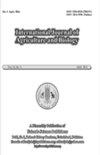转DB1基因水稻系等对褐飞虱的抗性
Q2 Agricultural and Biological Sciences
引用次数: 0
摘要
褐飞虱是水稻的主要害虫。开发抗褐飞虱的水稻是一种经济和环境友好的方法。为了克服这一问题,已经设计了一个含有DB1(薯蓣块茎凝集素1)转基因的转基因水稻系。本试验的目的是获得DB1水稻品系(DB1插入品种台中65)和一些水稻基因型对两个BPH群体的抗性水平。对褐飞虱的偏好、蜜露排泄、作物危害和种群发育进行了抗性研究。使用两种生物型BPH进行抗性测试,即生物型2(Sukamandi)和生物型3(北苏门答腊)。结果表明,转DB1基因的水稻对生物型2具有中度抗性,而对生物型3具有感病性,表明DB1基因提高了抗性水平,从感病变为中度抗性。所有测试的基因型均由生物型2选择用于产卵,而对于生物型3,优选五种基因型(DB1转基因系、PTB-33、Babawee、IR-64和IR-42)。基因型在前列腺增生的数量上有显著差异,PTB-33的基因型明显低于其他基因型。基因型的蜜露排泄在生物型2和3上表现出相同,除了在IR42的生物型3(对BPH敏感)上表现出大量粪便。与其他物种相比,PTB33的BPH种群数量较低,表明其对来自印度尼西亚的生物型2和3 BPH具有高抗性。©2021 Friends Science出版社本文章由计算机程序翻译,如有差异,请以英文原文为准。
Resistance of DB1 Transgenic Rice Line and others against Nilaparvata lugens, Brown Planthopper
Nilaparvata lugens (Stål), brown planthopper (BPH) is as a major pest of rice crop. Developing rice resistant to BPH is an economically and environmentally friendly approach. A transgenic rice line with DB1 (Dioscorea batatas tuber lectin 1) transgene has been engineered to overcome the problem. The objective of the experiment was to obtain the level of resistance of a DB1 rice line (DB1-inserted cv. Taichung 65) and some rice genotypes against two colonies of BPH. Resistance study was performed in BPH’s preference, honeydew excretion, crop damage, and population development. The resistant test was carried out using two biotypes BPH i.e., biotype 2 (Sukamandi) and biotype 3 (North Sumatera). The result showed that DB1 transgenic rice was moderately resistant to biotype 2, while to be susceptible when invested to biotype 3, indicating that the DB1 gene increases the resistance level, from susceptible to moderately resistant. All tested genotypes were chosen by biotype 2 for laying eggs, while for biotype 3 preferred five genotypes (DB1 transgenic line, PTB-33, Babawee, IR-64 dan IR-42). Genotype significantly differed on number of BPH and was considerably lower on PTB-33 than the others. Honeydew excretion of genotypes showed equal on biotype 2 and 3, except on biotype 3 of IR 42 (susceptible to BPH) which showing high amount of feces. PTB 33 had lower BPH population as compared to others, indicating high resistance to BPH of biotype 2 and 3 from Indonesia. © 2021 Friends Science Publishers
求助全文
通过发布文献求助,成功后即可免费获取论文全文。
去求助
来源期刊

International Journal of Agriculture and Biology
AGRICULTURE, MULTIDISCIPLINARY-
CiteScore
1.70
自引率
0.00%
发文量
40
审稿时长
5 months
期刊介绍:
Information not localized
 求助内容:
求助内容: 应助结果提醒方式:
应助结果提醒方式:


